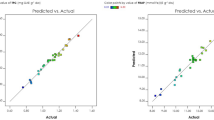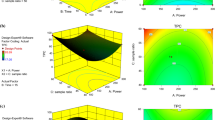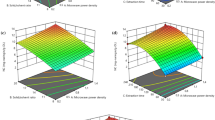Abstract
The present study aims to increase the efficiency of a resource from waste to health by valorisation of it through cleaner, eco-friendly and less energy-consuming technical processes such as microwave-asissted (MAE) and supercritical fluid (SFE) extractions. On the other hand, optimization of the processes have been applied utilizing multivariate statistic technique such as Response surface Methodology (RSM) in order to consider any possible interaction between variables with less number of experiments as well as to model a response affected by several variables. The outcome of the present study indicates that the optimum conditions for MAE were 275 W of microwave power together with 2 g mandarin leaf for 45 s; regarding SFE, 50 °C, 200 bar and 0.39 mL/min was found as the optimal condition to obtain the maximum yields of each dependent variable such as total phenolic material (TPM) and total flavonoid material (TFM), respectively. Additionally, antioxidant activity values measured by several methods such as cupric ion reducing antioxidant capacity (CUPRAC), 2,2-diphenyl-1-picrylhydrazyl (DPPH) and 2,2′-azino-bis-(3-ethylbenzothiazoline-6-sulfonic acid) diammonium salt (ABTS) were correlated positively with both TPM and TFM in the leaf extracts. Furthermore, scanning electron microscope (SEM) images indicated cell wall disruption in all the treatement groups compared to untreated samples.







Similar content being viewed by others
References
Dillard, C.J., German, J.B.: Phytochemicals: nutraceuticals and human health: a review. J. Sci. Food Agric. 80, 1744–1756 (2000)
Rice-Evans, C.A., Miller, N.J., Paganga, G.: Structure-antioxidant activity relationships of flavonoids and phenolic acids. Free Radic Biol Med. 20, 933–956 (1996)
Rispail, N., Morris, P., Webb, K.J.: Phenolic compounds: extraction and analysis. In: Marquez, A. J. (ed.) Lotus japonicas handbook, pp. 349–355. Springer, Netherlands (2005)
Heim, K.E., Tagliaferro, A.R., Bobilya, D.J.: Flavonoid antioxidants: chemistry, metabolism and structure-activity relationships. J. Nutr. Biochem. 13, 572–584 (2002)
Ryan, D., Antolovich, M., Prenzler, P., Robards, K., Lavee, S.: Biotransformations of phenolic compounds in Olea europaea. L. Sci Hortic. 92, 147–176 (2002)
Vermerris, W., Nicholson, R.: Phenolic compounds and their effects on human health. Phenolic compound biochemistry, pp. 235–255. Springer, Netherlands (2006)
Vinson, J.A., Dabbagh, Y.A., Serry, M.M., Jang, J.: Plant flavonoids, especially tea flavonols, are powerful antioxidants using an in vitro oxidation model for heart disease. J. Agric. Food Chem. 43, 2800–2802 (1995)
Saatci, N., Mur, B.Y.: Relationships between the concentrations of iron, macro and micro nutrients in Satsuma Mandarine leaves (citrus reticuláta Blanco). J. Plant Nutr. 23, 1745–1750 (2000)
Wilmsen, P.K., Spada, D.S., Salvador, M.: Antioxidant activity of the flavonoid hesperidin in chemical and biological systems. J. Agric. Food Chem. 53, 4757 (2005)
Bocco, A., Cuvelier, M.E., Richard, H., Berset, C.: Antioxidant activity and phenolic composition of citrus peel and seed extracts. J. Agric. Food Chem. 46, 2123 (1998)
Dahmoune, F., Boulekbache, L., Moussi, K., Aoun, O., Spigno, G., Madani, K.: Valorization of Citrus limon residues for the recovery of antioxidants: evaluation and optimization of microwave and ultrasound application to solvent extraction. Ind. Crop Prod. 50, 77 (2013)
Sun, Y., Liu, D., Chen, J., Ye, X., Yu, D.: Effects of different factors of ultrasound treatment on the extraction yield of the all-trans-β-carotene from citrus peels. Ultrason. Sonochem. 18, 243 (2001)
Balasundram, N., Sundram, K., Samman, S.: Phenolic compounds in plants and agri-industrial by-products: antioxidant activity, occurrence, and potential uses. Food Chem. 99, 191 (2006)
Galanakis, C.M.: Recovery of high added-value components from food wastes: conventional, emerging technologies and commercialized applications. Trends Food Sci Tech. 26, 68 (2012)
Galanakis, C.M.: Emerging technologies for the production of nutraceuticals from agricultural by-products: a viewpoint of opportunities and challenges. Food Bioprod Process. 91, 575 (2013)
Zinoviadou, K.G., Galanakis, C.M., Brnčić, M., Grimi, N., Boussetta, N., Mota, M.J., Saraiva, J.A., Patras, A., Tiwari, B., Barba, F.J.: Fruit juice sonication: implications on food safety and physicochemical and nutritional properties. Food Res Int. 77, 743 (2015)
Barbaa, F.J., Galanakis, C.M., Esteve, M.J., Frigola, A., Vorobiev, E.: Potential use of pulsed electric technologies and ultrasounds to improve the recovery of high-added value compounds from blackberries. J Food Eng. 167, 38 (2015)
Elena Rosello-Soto, E., Galanakis, C.M., Brncic, M., Orliend, V., Trujilloe, F.J., Mawsonf, R., Knoerzerf, K., Tiwarig, B.K., Barbaa, F.J.: Clean recovery of antioxidant compounds from plant foods, byproducts and algae assisted by ultrasounds processing. Modeling approaches to optimize processing conditions. Trends Food Sci Tech. 42, 134 (2015)
Chemat, F., Rombaut, N., Meullemiestre, A., Turk, M., P´erino-Issartier, S., Fabiano-Tixier, A.-S., Vian, M.: Review of green food processing techniques. Preservation, transformation, and extraction. Innov. Food Sci. Emerg. Technol. 41, 357 (2017)
Jacotet-Navarro, M., Rombaut, N., Deslis, S., Fabiano-Tixier, A.-S., Pierre, F.-X., Bily, A., Chemat, F.: Towards a “dry” bio-refinery without solvents or added water using microwaves and ultrasound for total valorization of fruit and vegetable by-products. Green Chem. 18, 3106
Sahin, S., Bilgin, M.: Study on oleuropein extraction from olive tree (Olea europaea) Leaves by means of SFE: comparison of water and ethanol as co-solvent. Separ. Sci. Technol. 47, 2391–2398 (2012)
Hayat, K., Hussain, S., Abbas, S., Farooq, U., Ding, B., Xia, S., Jia, C., Zhang, X., Xia, W.: Optimized microwave-assisted extraction of phenolic acids from citrus mandarin peels and evaluation of antioxidant activity in vitro. Sep. Purif. Technol. 70, 63–70 (2009)
Hayat, K., Zhang, X., Farooq, U., Abbas, S., Xia, S., Jia, C., Zhong, F., Zhang, J.: Effect of microwave treatment on phenolic content and antioxidant activity of citrus mandarin pomace. Food Chem. 123, 423 (2010)
Hayat, K., Zhang, X., Chenc, H., Xia, S., Jia, C., Zhong, F.: Liberation and separation of phenolic compounds from citrus mandarin peels by microwave heating and its effect on antioxidant activity. Sep. Purif. Technol. 73, 371 (2010)
Kırbaşlar, Şİ., Kırbaşlar, F.G.: Composition of Turkish mandarin and bergamot leaf oils. J. Essent. Oil Res. 18, 318 (2006)
Sahin, S.: A novel technology for extraction of phenolic antioxidants from mandarin (Citrus deliciosa Tenore) leaves: solvent-free microwave extraction. Korean J. Chem. Eng. 32(5), 950–957 (2015)
Bakar, J., Gadi, M., Suhaila, A., Md. Zaidul, I.S.: Phenolics in Citrus hystrix leaves obtained using supercritical carbon dioxide extraction. Phenolics in Citrus hystrix leaves obtained using supercritical carbon dioxide extraction. Int. Food Res. J. 18, 941–948 (2011)
Cavero, S., García-Risco, M.R., Marín, F.R., Jaime, L., Santoyo, S., Señoráns, F.J., Reglero, G., Ibañez, E.: Supercritical fluid extraction of antioxidant compounds from oregano chemical and functional characterization via LC–MS and in vitro assays. J. Supercrit. Fluid. 38, 62–69 (2006)
Roy, B.C., Hoshino, M., Ueno, H., Sasaki, M., Goto, M.: Supercritical carbon dioxide extraction of the volatiles from the peel of Japanese citrus fruits. J. Essent. Oil Res. 19, 78–84 (2007)
Kirbaşlar, Ş.İ., Gök, A., Kirbaşlar, F.G., Tepe, S.: Volatiles in Turkish clementine (Citrus clementina Hort.) peel) exist. J. Essent. Oil Res. 24, 153–157 (2012)
Pérez, L., Conde, E., Dominguez, H.: Microwave hydrodiffusion and gravity processing ofSargassum muticu. Process Biochem. 49, 981 (2014)
Şahin, S., Bilgin, M., Dramur, M.U.: Investigation of oleuropein content in olive leaf extract obtained by supercritical fluid extraction and soxhlet methods. Separ. Sci. Technol. 46, 1829–1837 (2011)
Malik, N.S.A., Bradford, J.M.: Changes in oleuropein levels during differentiation and development of floral buds in ‘Arbequina’ olives. Sci Hortic. 110, 274 (2006)
Sakanaka, ,S., Tachibana, Y., Okada, Y.: Preparation and antioxidant properties of extracts of Japanese persimmon leaf tea (kakinoha-cha). Food Chem. 89, 569 (2005)
Yu, J., Wang, L., Walzem, R.L., Miller, E.G., Pike, L.M., Patil, B.S.: Antioxidant activity of citrus limonoids, flavonoids, and coumarins. J. Agric. Food Chem. 53, 2009 (2005)
Şahin, S., Şamlı, R.: Optimization of olive leaf extract obtained by ultrasound-assisted extraction with response surface methodology. Ultrason. Sonochem. 20, 595 (2013)
Bilgin, M., Şahin, S., Dramur, M.U., Sevgili, M.L.: Obtaining scarlet sage (salvia coccinea) extract through homogenizer- and ultrasound-assisted extraction methods. Chem. Eng. Commun. 200, 1197 (2013)
Re, R., Pellegrini, N., Proteggente, A., Pannala, A., Yang, M., Rice-Evans, C.: Antioxidant activity applying an improved ABTS radical cation decolorization assay. Free Radic. Biol. Med. 26, 1231 (1999)
Apak, R., Güçlü, K., Özyürek, M., Çelik, S.E.: Mechanism of antioxidant capacity assays and the CUPRAC (cupric ion reducing antioxidant capacity) assay. Microchim. Acta. 160, 413 (2008)
Draper, N.R., John, J.A.: Theory and methods: response surface designs where levels of some factors are difficult to change. Aust. NZ. J. Stat. 30, 423 (1998)
Périno-Issartier, S., Zill-e-Huma, A.V., Abert-Vian, M., Chemat, F.: Solvent free microwave-assisted extraction of antioxidants from sea buckthorn (Hippophae rhamnoides) food by-products. Food Bioprocess Technol. 4, 1020 (2011)
Pan, X., Ni, G., Liu, H.: Microwave-assisted extraction of tea polyphenols and tea caffeine from green tea leaves. Chem. Eng. Process. 42, 129 (2003)
Karabegovic, I.T., Stojičević, S.S., Veličković, D.T., Nikolić, NČ., Lazić, M.L.: Optimization of microwave-assisted extraction of cherry laurel fruit. Separ. Sci. Technol. 49, 416 (2014)
Ballard, T.S., Mallikarjunan, P., Zhou, K., O’Keefe, S.: Microwave-assisted extraction of phenolic antioxidant compounds from peanut skins. Food Chem. 120, 1185 (2010)
Martinez, J.L.: Supercritical Fluid Extraction of Nutraceuticals and Bioactive Compounds. Taylor and Francis Group, Boco Raton (2007)
Malik, N.S.A., Bradford, J.M.: Recovery and stability of oleuropein and other phenolic compounds during extraction and processing of olive (Olea europaea L.) leaves. J. Food Agric. Environ. 6, 8–13 (2008)
Le Floch, F., Tena, M.T., Rios, A., Valcarcel, M.: Supercritical fluid extraction of phenol compounds from olive leaves. Talanta. 46, 1123–1130 (1998)
Hsu, R.C., Lin, B.H., Chen, C.W.: The study of supercritical carbon dioxide extraction for ganoderma lucidum. Ind. Eng. Chem. Res. 40, 4478–4481 (2001)
Wang, L., Weller, C.L.: Recent advances in extraction of nutraceuticals from plants. Trends Food Sci. Tech. 17, 300–312 (2006)
Bayçın, D., Altıok, E., Ülkü, S., Bayraktar, O.: Adsorption of olive leaf (Olea europaea L.) antioxidants on silk fibroin. J. Agric. Food Chem. 55, 1227–1236 (2007)
Seader, J.D., Henley, E.J.: Separation Process Principles, Inc, p. 641. Wiley, New York (1998)
Lee, M.R., Lin, C.Y., Li, Z.G., Tsai, T.F.: Simultaneous analysis of antioxidants and preservatives in cosmetics by supercritical fluid extraction combined with liquid chromatography–mass spectrometry. J. Chromatogr. A. 1120, 244–251 (2006)
Mira, B., Blasco, M., Berna, A., Subirats, S.: Supercritical CO2 extraction of essential oil from orange peel. Effect of operation conditions on the extract composition. J. Supercrit. Fluid. 14, 95–104 (1999)
Chen, X., Zhang, Y., Zu, Y., Fu, Y., Wang, W.: Composition and biological activities of the essential oil from Schisandra chinensis obtained by solvent-free microwave extraction. Food Sci. Technol. 44, 2047–2052 (2011)
Li, H., Wang, X., Li, P., Li, Y., Wang, H.: Comparative study of antioxidant activity of grape (Vitis vinifera) seed powder assessed by different methods. J. Food Drug Anal. 16, 67–73 (2008)
Li, H., Wang, X., Li, P., Li, Y., Wang, H.: Polyphenolic compounds and antioxidant properties of selected China wines. Food Chem. 112, 454–460 (2009)
Zhou, H.Y., Liu, C.Z.: Microwave-assisted extraction of solanesol from tobacco leaves. J. Chromatogr. A. 135, 1129 (2006)
Kong, Y., Fu, Y.-J., Zu, Y.-G., Liu, W., Wang, W., Hua, X., Yang, M.: Ethanol modified supercritical fluid extraction and antioxidant activity of cajaninstilbene acid and pinostrobin from pigeonpea. Food Chem. 117, 152 (2009)
Acknowledgements
The authors wish to thank for the support of the Research Fund of Istanbul University (Bilimsel Araştirma Projeleri Birimi, Istanbul Üniversitesi). Project number is 41685.
Author information
Authors and Affiliations
Corresponding author
Rights and permissions
About this article
Cite this article
Ateş, F., Şahin, S., İlbay, Z. et al. A Green Valorisation Approach Using Microwaves and Supercritical CO2 for High-Added Value Ingredients from Mandarin (Citrus deliciosa Tenore) Leaf Waste. Waste Biomass Valor 10, 533–546 (2019). https://doi.org/10.1007/s12649-017-0074-z
Received:
Accepted:
Published:
Issue Date:
DOI: https://doi.org/10.1007/s12649-017-0074-z




